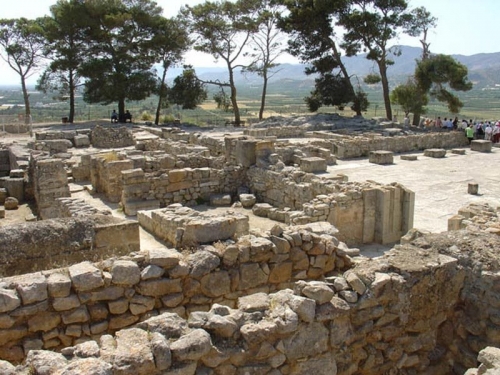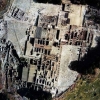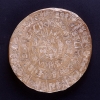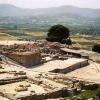Phaistos
Phaistos is built on a low hill (altitude of about 100m from sea level), in the south of river Geropotamos (ancient river Lithaios), and dominates the fertile valley of Kato Mesara, which is surrounded by imposing mountains (Psiloritis, Asterousia, Lasithi Mountains).
The Libyan Sea extends in the south. Lithaios surrounds the hill of Phaistos in the east and the north and was a source of water supply for the city. The mild and warm climate of the area made the life of its residents comfortable and pleasant. Phaistos was one of the most important centres of the Minoan civilization, and the most wealthy and powerful city of southern Crete. It is mentioned in the texts of ancient writers (Diodorus, Stravon, Pausanius) and Homer. It is one of the three important cities founded in Crete by Minos. According to mythology, the dynasty of Rodamanthus, the son of Zeus and brother of Minos, reigned in it. Homer refers to its participation in the Trojan War and describes it as a “well populated” city. The period of prosperity in Phaistos began with the coming of the Bronze Age in Crete in the middle of the 3rd millennium B.C., when the foundations of the Minoan civilization were laid.
Habitation in Phaistos started in the Neolithic period, as revealed by the foundations of Neolithic houses, tools, statuettes and potsherds discovered under the palace during the excavations. The Neolithic settlement is believed to have covered the top of the hill and its southwestern slope. In the middle of the 3rd millennium B.C. the use of metals began, which favoured the development of the city.
Development continued until the foundation and consolidation of the Minoan palaces (15th century B.C.). In the beginning of the 2nd millennium kings took the rule and established large palaces. The first palace was built in around 1900 B.C. and along with its surrounding buildings it covered an area of 18.000 m2, a little smaller than that of the palace of Knossos. The major earthquake in around 1700 B.C. was the cause of its destruction and the destruction of Knossos. A new, more imposing one was built in its place. Most of the remnants preserved today belong to it, while some parts of the first palace, mainly in the southeast, have also been discovered. The Minoan city covered a considerable area around the palatial centre.
Phaistos was the seat of the king – ruler who controlled not only the rich plain of Mesara and the settlements in the wider area but also the exit to the sea and the harbours of the gulf of Mesara. After the destruction of the palace (15th century B.C.) the city of Phaistos continued to be inhabited in the Mycenaean and Geometric periods (8th century B.C.). In the following centuries Phaistos experienced a new period of prosperity. The area of the city grew in relation to its area in the Minoan times. It became a rich, strong and densely populated independent city. It minted its own coin and during its period of prosperity, its rule extended from cape Lithino to cape Melissa, including the islets Paksimadia (ancient name: Litoae). The state of Phaistos had two powerful harbours, Matala and Kommo in the southeast.
In historical times the temple of Rhea was built south of the old palace. A time gap is observed in the classical period, from which no architectural remnants have been discovered yet. In contrast, the Hellenistic city was extremely prosperous. Houses of that period can be seen in the west yard (upper terrace) of the palace. In the middle of the 2nd century B.C. (around 1600 B.C.) the city was destroyed and occupied by the neighbouring city of Gortys. Even though it was not immediately abandoned, Phaistos lost its power. Traces of habitation dating from the Venetian period are scattered in the whole area. The modern village of Agios Ioannis on the southern fringe of the ancient city is the modest remainder of a glorious past.
From archaeological view, Phaistos is the second in importance Minoan city after Knossos. The site of Knossos was first identified by British captain H. Spratt. The archaeological research of Phaistos was started in 1884 by F. Halbherr and continued by the Italian School of Archaeology (Halbherr and L. Pernier, 1900-1904) and by Doro Levi (1950-1971). Restoration works were conducted during the excavations by the Italian School of Archaeology. Some spaces, mainly the old palace and the royal rooms of the new palace were covered with plastic shelters, while others, such as the storehouses of the new palace, were covered with concrete slabs.










